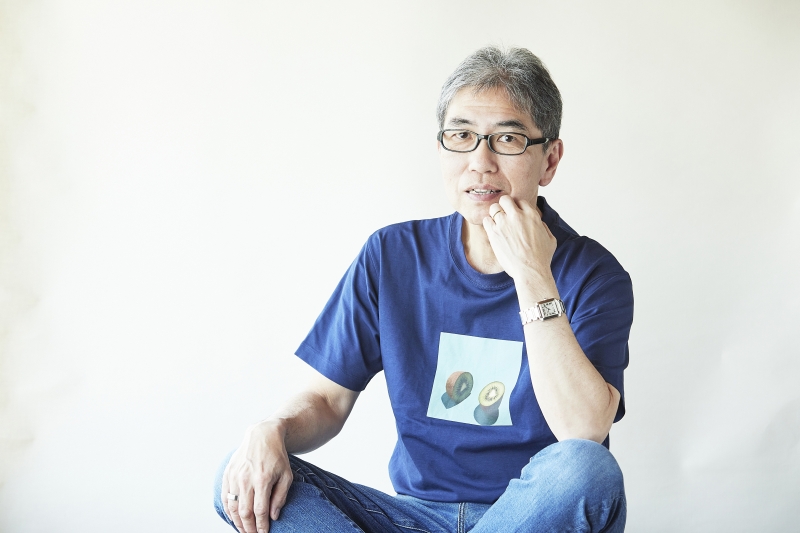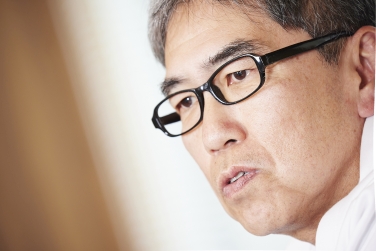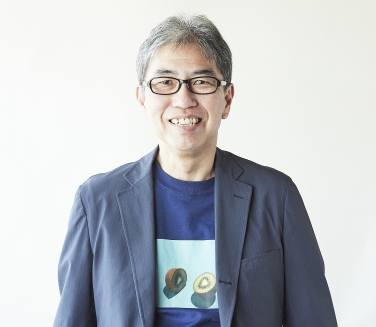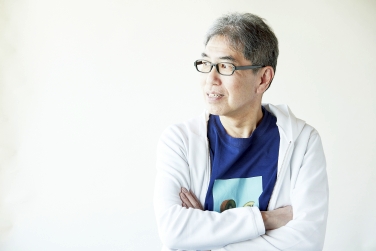Message from CEO
A startup with 26,000 employees! We are transforming ourselves for Resonac to “change society”
- What I Want to Achieve at Resonac
- What We are Pursuing Now to Achieve this
- Development of Co-creative Human Resources and the Cultivation of Organizational Culture
- Refining Materials Creation
- Building a Business Portfolio with a Focus on Shareholder and Investor Perspectives
- Gaining Empathy from Shareholders and Investors
What I Want to Achieve at Resonac
In January 2023, Showa Denko and Hitachi Chemical were integrated to form the functional chemical manufacturer Resonac. This is often referred to as the second founding, and I rather consider myself as a founder. As the founder of a startup company with 26,000 employees, what I want to realize, as stated in our purpose, is to change society through the power of chemistry. It is true that the chemical industry has its lights and shadows.
Chemistry has contributed to the development of industries and affluent lives by creating materials for products such as plastics, semiconductors, and electronic components, which are indispensable in our daily lives. The reason I am in the chemical industry is that I was fascinated by the potential of chemistry. On the other hand, chemistry has continued to damage the global environment, such as CO2 emissions and marine plastics.

I have two favorite books. One is “Free to Choose” by Milton Friedman, and the other is “Silent Spring” by Rachel Carson. While Friedman affirmed the pursuit of growth by companies in a survival-of-the-fittest capital market, Rachel Carson sounded the alarm about environmental pollution caused by chemical manufacturers. The economy and the environment, once considered to be a dichotomy, we are now seeking a balance under the keyword sustainability. That’s why I believe we can change society through the power of chemistry in this era.
The reason I want to take the lead in changing society through the power of chemistry is driven by a strong sentiment. It is anger and introspection regarding the current state of Japan. I love both Japan and the Japanese people, but I wonder why Japan is always trailing behind the world in various fields, why many talented Japanese cannot compete on a global level, why Japan’s GDP per capita is only half of Singapore. I feel frustration about these things and regret that I couldn’t change this situation as a business leader. I want to create a world-class functional chemical manufacturer from Japan. I want to change the industry’s conventional practice to achieve this. This is my desire and responsibility.
However, my aspirations can’t be realized by my abilities alone. That’s why we need to co-create with various companies, including competitors, and many stakeholders, innovate, and grow. For this to happen, Resonac first needs to change. The new company name “Resonac” was created by combining the word “resonate” and the “C” of “chemistry.” As the name of our company suggests, we seriously want to transform society as a Co-creative Chemical Company.
What We are Pursuing Now to Achieve this
A certain scale of business and high profitability are required to become a world-class functional chemical manufacturer. If we don’t generate a good profit as a company, we cannot contribute to society or invest in innovation. To be a “good company,” we first need to be a profitable company. For this reason, Resonac aims to achieve a 20% EBITDA margin by 2025, while maintaining net sales of ¥1 trillion.
What Resonac wants to achieve after becoming profitable is to bring innovation to society. Chemistry is the starting point of all industries. We definitely need the power of chemistry to bring innovation to society. We will pursue the power of chemistry for that purpose, and even if we acquire highly competitive technology and know-how through co-creation, we do not intend to keep them to ourselves at all. I believe that is our responsibility as a chemical company and the ideal form of a Co-creative Chemical Company.

For example, one of the important innovations that Resonac should bring about is reducing environmental load. We are currently taking various measures toward carbon neutrality, and of course, various chemical companies are innovating their own techniques and proceeding on their own paths. I believe that such efforts will reveal a winning strategy in the near future. Even if we can seize that winning strategy, I would like to make our technology and know-how open so that the entire industry can work on it.
There are three things Resonac should promote to change society through the power of chemistry. The first is human resource development and corporate culture change. This is the most important issue. The second is to refine material creation, in other words, to innovate materials that support the evolution of semiconductors and electronic components with as much added value as possible with the power of chemistry. The third is to maximize corporate value by effective business portfolio management easily understandable for shareholders and investors.
Development of Co-creative Human Resources and the Cultivation of Organizational Culture
The differentiating factor for corporate growth lies in whether the management team has the gustiness to carry out the strategy and whether the human resources to support it have been developed. As the CEO of Resonac, what I prioritize the most is the development of human resources to enhance individual capabilities and corporate culture change. I believe that achieving this will lead to the maximization of corporate value.
To enhance individual capabilities, we have established several training programs, such as training sessions to bolster the co-creative collaboration capabilities and co-creative leadership training. For the cultivation of organizational culture, employees frequently hold roundtables, town hall meetings, and Moyamoya Meetings at their workplaces.
The Moyamoya Meeting is a symbolic initiative to maximize Resonac’s corporate value, and it started this January. About 20 young employees gather and raise three things they are typically frustrated or concerned about, and I and CHRO Imai facilitate the discussion, encouraging open and frank dialogue. The important thing is not to set a theme in advance. Young employees always have something they are concerned about. This meeting is not about solving these concerns but an opportunity to think about how our Values can support them, and it’s also a chance to bring young voices to the management team.

First, as the first round, we think about whether participants’ concerns can be solved with our four Values, specifically, Passionate & Results- Driven, Agile & Flexible, Open Minds & Open Connections, and Solid Vision & Solid Integrity. The issues are grouped into categories: those that can be resolved by an individual, those that can be resolved collectively, and those that cannot be resolved through our Values. By going through this process, participants will understand how to use Values.
In the second round, participants prioritize the concerns that can be resolved with Values in terms of effectiveness and importance and propose solutions to the plant managers present. Employees’ concerns often get stopped at their immediate supervisors and tend not to easily reach the plant managers as the top management. Conversely, the plant managers also have the opportunity to hear directly from young employees. Additionally, if there are any obstacles that make it difficult for a plant manager to decide whether to adopt a solution, I can also remove those obstacles on the spot.
While the purpose of the Moyamoya Meeting is to deepen understanding of Values, what I want to convey most is “enjoy your work and face things with a more open mind”. I believe it’s essential for me, as the CEO, to actively participate and contribute in these meetings in order to create an environment where we promote co-creation based upon our Values.
There are two keywords for co-creative human resources. One is co-creation, and the other is autonomy. Japanese people often operate efficiently within a vertical command system, following top-down directives, but there can sometimes be a lack of collaboration when it comes to lateral interactions. People who can navigate this are co-creative human resources.
The portfolio strategy and human resources strategy must match in Resonac’s human capital management. The portfolio strategy is to transform into a specialty chemical company. We must move from being a traditional diversified chemical manufacturer centered on petrochemicals to a functional specialty chemical company. In specialty chemicals, sales representatives listen to customer requests, and the development division purchases materials, produces prototypes, verifies them, and then proposes them to customers. This requires negotiation and communication skills. While it might seem obvious, in the traditional bulk chemical industry, this kind of careful alignment wasn’t necessary. Instead, top-down commands were most important in petrochemical complexes to prevent accidents. Our company’s shift toward specialty chemicals and developing co-creative, autonomous human resources are the two main drivers for maximizing corporate value, and this is the essence of Resonac’s human capital management.
The strength of Resonac’s human capital management lies in the complete synchronization of the CEO and the CHRO, dedicating our all to it. Another strength I pride myself on is having a clear vision for the company 10 years from now. This is drawn from my experience at the General Electric Company (GE), where I used to work for. They were sharing values and fostering competition. Although there was a sense of tension, because values were shared, everyone was able to feel a sense of accomplishment when they succeeded. I strongly feel that I want to create that world.
I tell our employees, “I will provide everyone with an equal opportunity. Choosing your career path is up to you. It’s not about work-life balance, but work-life choice.” While the company offers you the opportunity to choose a way of living and working that makes yourself feel happy, don’t think that you are unhappy because your way is different from others. Naturally, if profitability differs depending on the business division in which you are enrolled, you may be envious of the business division next door. That’s why we offer job rotations and internal job postings. Since learning opportunities vary by business, you can experience various roles in sequence, promoting personal growth.
At this year’s acceptance ceremony, I said, “I don’t know what the industrial structure will look like 30 years from now, and I won’t make any light promises about that future. Instead, I promise to turn you into individuals who can thrive anywhere.” This, I believe, is the hallmark of a genuinely employee-friendly company, and I want to make Resonac a “dojo” - a place that trains individuals society needs.
Additionally, Resonac has adopted a Chief X Officer (CXO) system. We have 23 business units and approximately 100 plants and offices, each of which operates independently with diverse business management methods. The CXO system facilitates cross-functional roles for them. For instance, a person in charge of finance in a business unit reports not to general manager of the business unit, but to the CFO. Similarly, the CHRO serves as the supervisor of each business unit’s personnel staff members. Finance and personnel representatives in each business unit, under the CFO and CHRO respectively, align with the policies of the headquarters while also acting as partners to general managers of business units. This organizational structure that emphasizes on horizontal connections can certainly be considered one of Resonac’s growth engines.
Refining Materials Creation
Within chemistry, semiconductors and electronic materials are one of the fields where Resonac will be able to demonstrate its strengths. In the field of semiconductor materials, Japanese companies, including Resonac, have a dominant presence in the world. In order to improve the quality of functional materials used in semiconductor materials, it requires the iteration of a wide range of experiments – an area where persistent Japanese firms excel, building formidable industrial barriers. On the other hand, the petrochemical industry is difficult to demonstrate its competitiveness, and earnings tend to fluctuate, affected by market conditions such as crude oil prices. In that sense, in the field of semiconductors and electronic materials, reorganization is needed to win, while in the petrochemical industry, reorganization is needed to avoid losing.”
At Resonac, synergies are gradually beginning to emerge between the strengths of the former Showa Denko and the former Hitachi Chemical. The fusion here is “Chemistry to Synthesize” of the former Showa Denko, which is strong in raw materials, and “Chemistry to Formulate” of the former Hitachi Chemical, which has a high market share in finished products for semiconductor manufacturers.

It is our strength that we can now address the performance requirements of semiconductor manufacturers comprehensively, going all the way back to resin materials. For example, we have a product called “copper-clad laminate” in printed wiring board materials, which holds the top market share globally. This product is manufactured by laminating copper foil, glass cloth, and resin, and the resin can be made from the molecular design level at the former Showa Denko. In addition, CMP slurry, the world’s top market share product in the mixtures used for polishing semiconductor wafers, can also be manufactured from the molecular design level of the particles, since the former Showa Denko has ceramic business. Indeed, by merging the know-how and technologies of both companies, we have triggered a “chemical reaction” to produce products with even higher specifications.
The integration is not something where results can be achieved overnight, but we believe it holds great upside potential for the future.
Building a Business Portfolio with a Focus on Shareholder and Investor Perspectives
In terms of portfolio strategy, we aim to transition from a traditional diversified chemical manufacturer centered on petrochemicals to a specialty chemical company that performs specific functions. To achieve this goal, we’ve been pushing for a transformation centered on profitability, positioning semiconductors and electronic materials as our core growth businesses, and have set a goal to increase their sales composition ratio from just over 30% to 45% by 2030. Growth should be achieved with this business. It is of utmost importance to continuously grow by developing quality materials successively without lagging behind the pace of our customers.
Meanwhile, we are currently reshuffling our portfolio, including selling off several businesses. For the petrochemical business, the focus is on increasing profit margins and safely operating the facilities. In the ceramics and resins business, the goal is to advance R&D and supply high-quality materials for semiconductors. If asked what corporate value means to me, it is the stock price. However, the stakeholder I spend the most time with is our employees. I publicly declare that the customer follows that. This does not mean that I take our shareholders and investors lightly. By investing my time in our employees and enhancing their engagement, and by building a strong relationship with our customers, I believe we can maximize our corporate value, leading to maximum returns for our shareholders and investors.
Gaining Empathy from Shareholders and Investors
The equity stories to persuade shareholders and investors are clear. They consist of the story of growing the semiconductor and electronic materials business and the story of preparing people and the organization for transformation. I want to clearly communicate to our shareholders and investors that we will endeavor to realize these two stories.
The current stock price and PBR levels are far from the image of Resonac I envision for 10 years from now. However, as Resonac develops the ability to generate profits, and gains understanding from our investors and shareholders that it will be able to achieve long term growth through strengthened business portfolio, and for that goal it is developing human resources and fostering an organizational culture, I believe the stock price and PBR will gradually reflect these factors. Recently, the number of long-term shareholders and investors who resonate with Resonac’s story is undoubtedly increasing. We will continue to passionately tell the Resonac’s story through proactive IR and SR activities. We hope you will join us in our excitement about Resonac’s mission to change society through the power of chemistry. We hope for your continued support in this endeavor.
While we will thoroughly explain the changes in our business portfolio to our shareholders and investors, we will not announce them as a medium- term management plan because I don’t see the point in setting numerical targets in the medium term. However, we will be sure to indicate the direction Resonac should take in the future, explain our non-financial KPIs based on materiality for sustainability and their progress, and the process we take toward them.

President and CEO
